Wondering what to eat in Lithuania during your first trip to the Baltic country? We spent a week eating our way through Vilnius. Discover twenty must-try Lithuanian food favorites to try when you visit too.
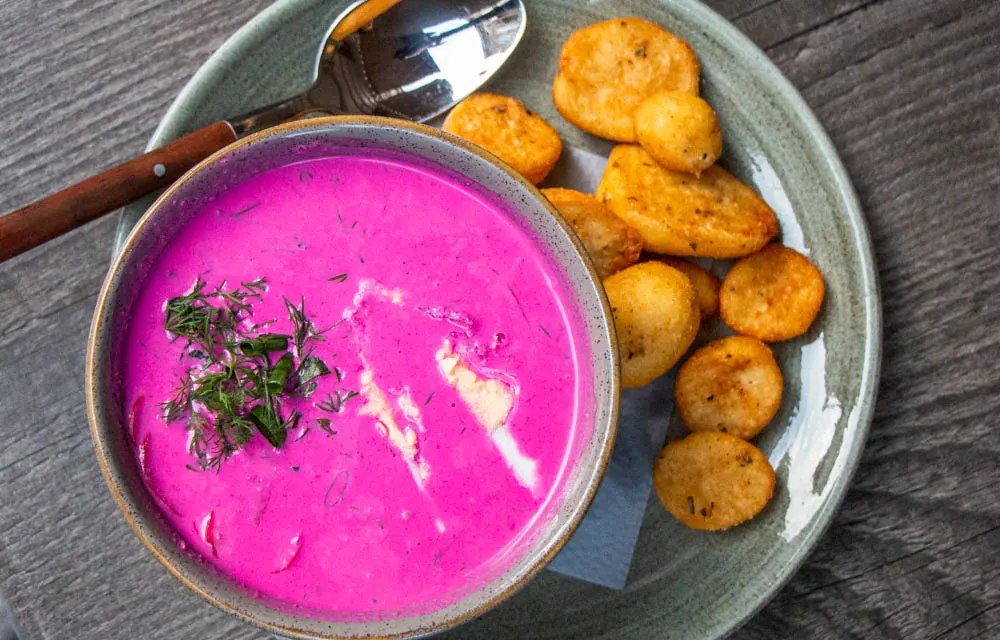
What is Lithuanian food?
First time travelers to Vilnius may wonder about the type of foods they’ll be eating during their visit. Before we spent a week eating our way through Vilnius, we wondered about the food in Lithuania too.
After our first bites and sips, we knew we were in for a week-long culinary adventure. From traditional food to modern cuisine, we tasted it all during a Vilnius food tour and at the best Vilnius restaurants. And guess what? We learned about the country’s storied past through our stomachs.
Lithuanian Food History
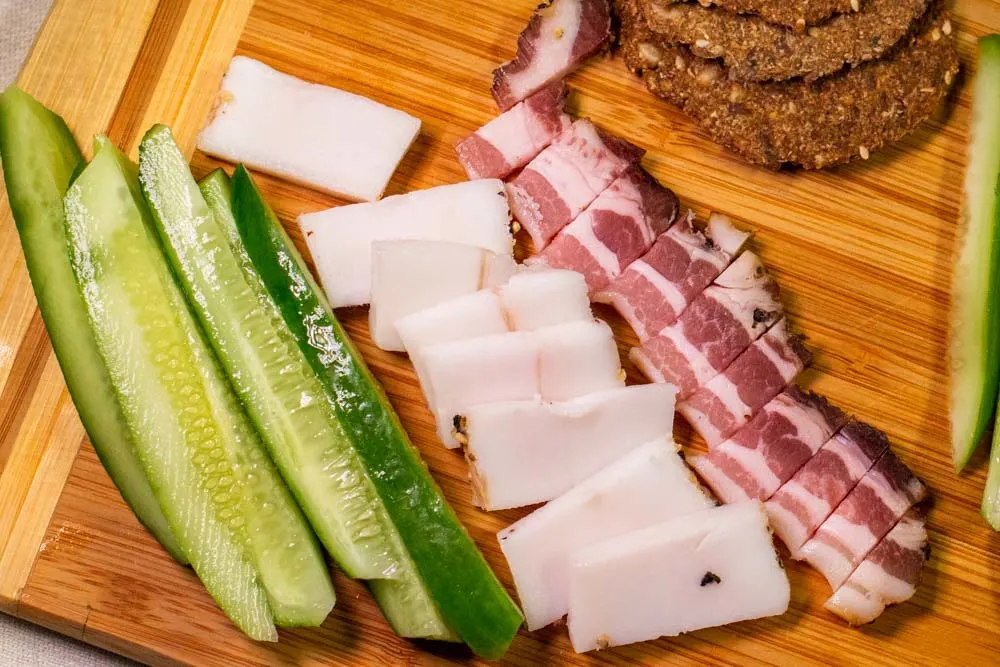
With a history that dates back to the middle ages, Lithuanian food traditions span the centuries. In many ways, Lithuania’s food mirrors a history filled with prosperity, melting cultures, oppression and rebirth.
Prosperity

A walk down the streets in Vilnius’ Old Town reveals architecture and statues that showcase the wealth and worldliness of the city’s past inhabitants. Ruled by dukes and inspired by scholars, Lithuania’s cuisine was originated by nobility and has been been refined over the ages.
Melting Cultures
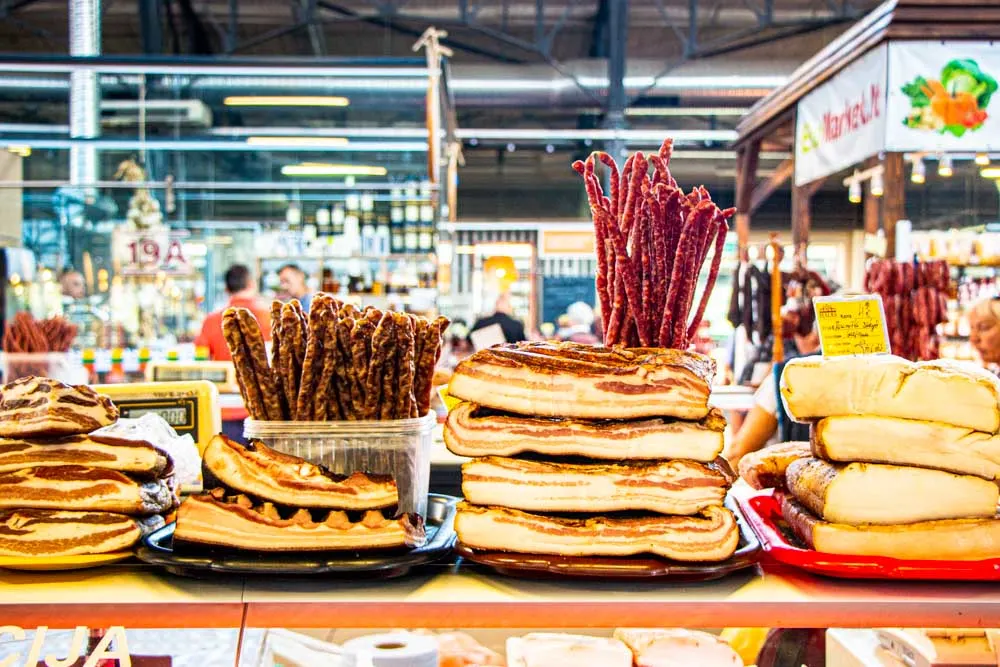
The line between traditional Polish food and traditional Lithuanian food is fuzzy at best. Both cuisines feature ingredients like potatoes and beets as well as some of the best dumplings in the world.
But Lithuanian cuisine also reflects influences from Italy, France, Germany, Turkey and Russia. Both Lithuania and its food were also influenced by a thriving Jewish population that, unfortunately, perished during the Second World War.
Oppression
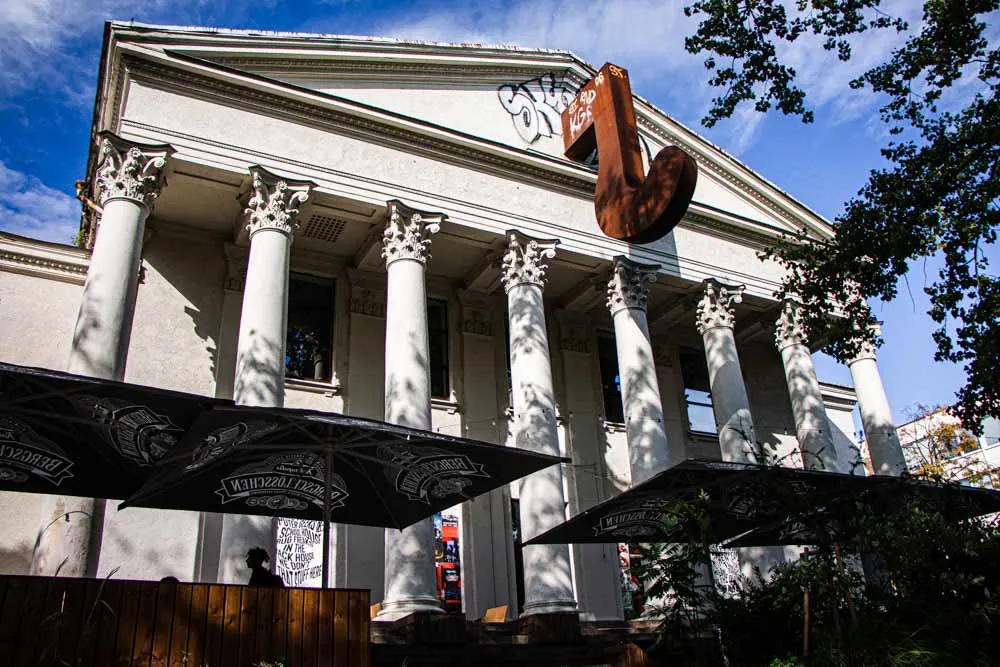
A study of Lithuania’s past reveals periods of enlightened renaissance and repressive occupation. The most recent invaders, Germany during World War II and Russia during the cold war era, caused the country to experience poverty and scarcity.
Lithuanians adopted a type of survival cuisine to combat this scarcity. Ironically, this way of eating has become trendy with its emphasis on local products and sustainability.
Rebirth
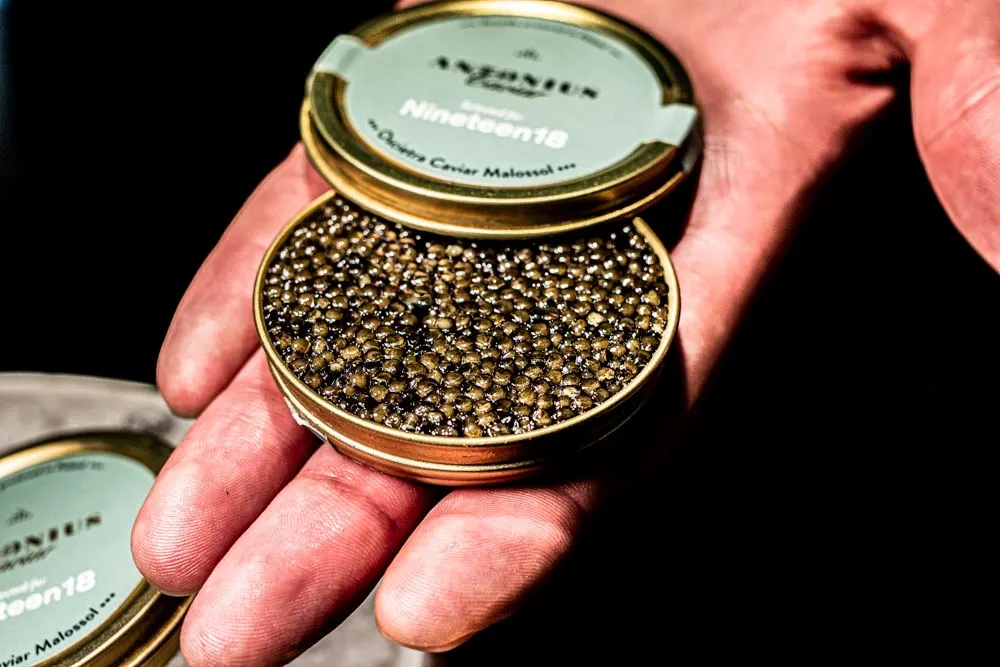
After more than a half-century under the rule of the Germans and Russians, Lithuania regained its independence in 1991. The country asserted its independent status by joining both the European Union and NATO in 2004.
Recent decades have signaled a rebirth with citizens embracing generational traditions while hopping on the latest developments in gastronomy. This rebirth has blossomed into a modern Lithuanian food culture that honors the past while embracing global culinary trends.
What to Eat in Lithuania
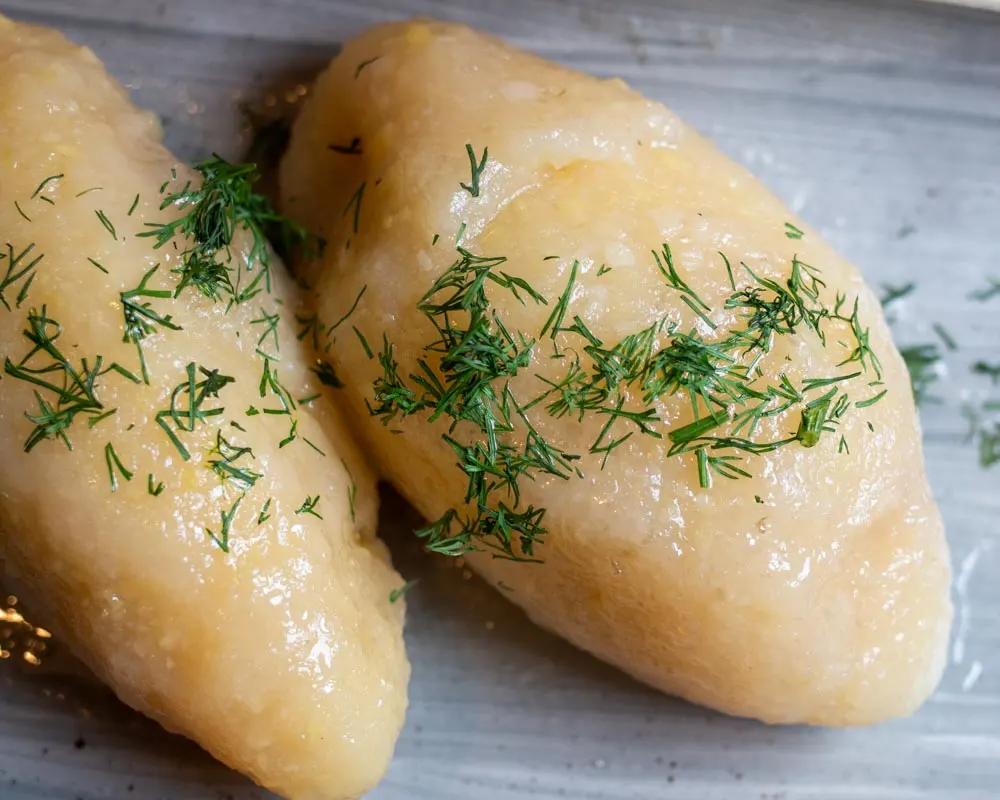
Regardless of why you’re visiting Lithuania, you’ll need to eat three meals a day. Whether you’re a food traveler like us or you’re visiting for other reasons, you’ll want to enjoy the best foods possible.
We dove into the Lithuania food scene during out time in Vilnius. Watch our YouTube video for a sneak preview of the food you’ll eat during your trip.
Read our Vilnius Restaurant Guide.
For ease of use, we’ve separated this guide into the following categories:
After a week of eating traditional Lithuanian food and so much more, these are our picks for the must-eat Lithuanian foods and drinks:
Traditional Food in Lithuania
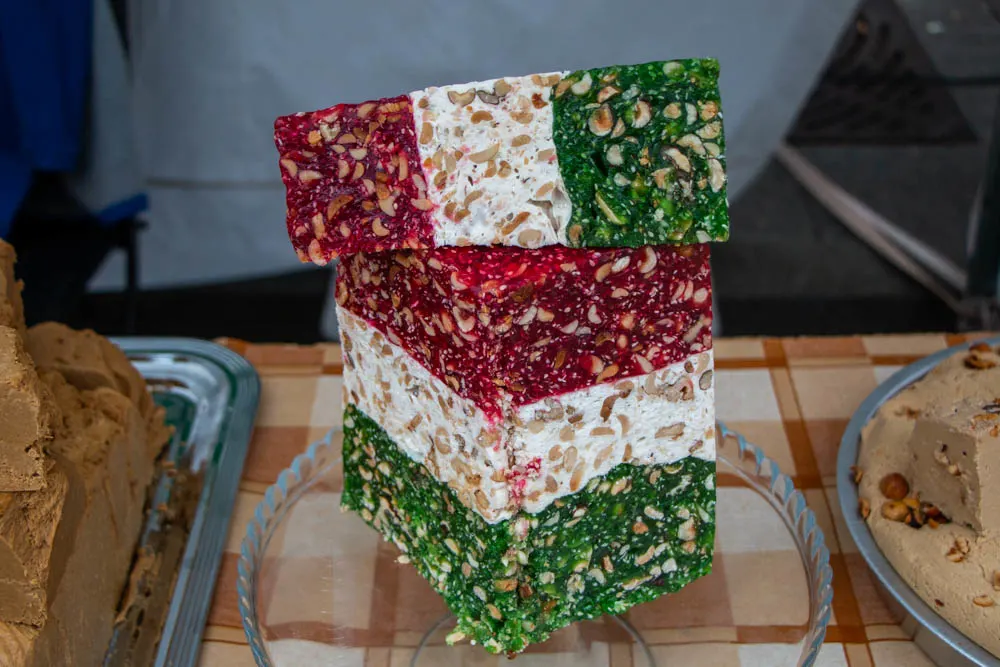
Like food in most Eastern European countries, traditional Lithuanian food is hearty, simple fare that warms the bones on a cold winter’s day. Typical ingredients include potatoes, rye seeds, beets and wild mushrooms – all items that grow throughout the country on farms and in forests.
We liken traditional food in Lithuania to comfort food for two reasons. First, it reminds us of holiday meals when our grandmothers would cook similar foods passed down from their grandmothers. But most of all because eating the following Lithuanian classics made us happy.
1. Cepelinai (Potato Dumplings Filled with Minced Meat)
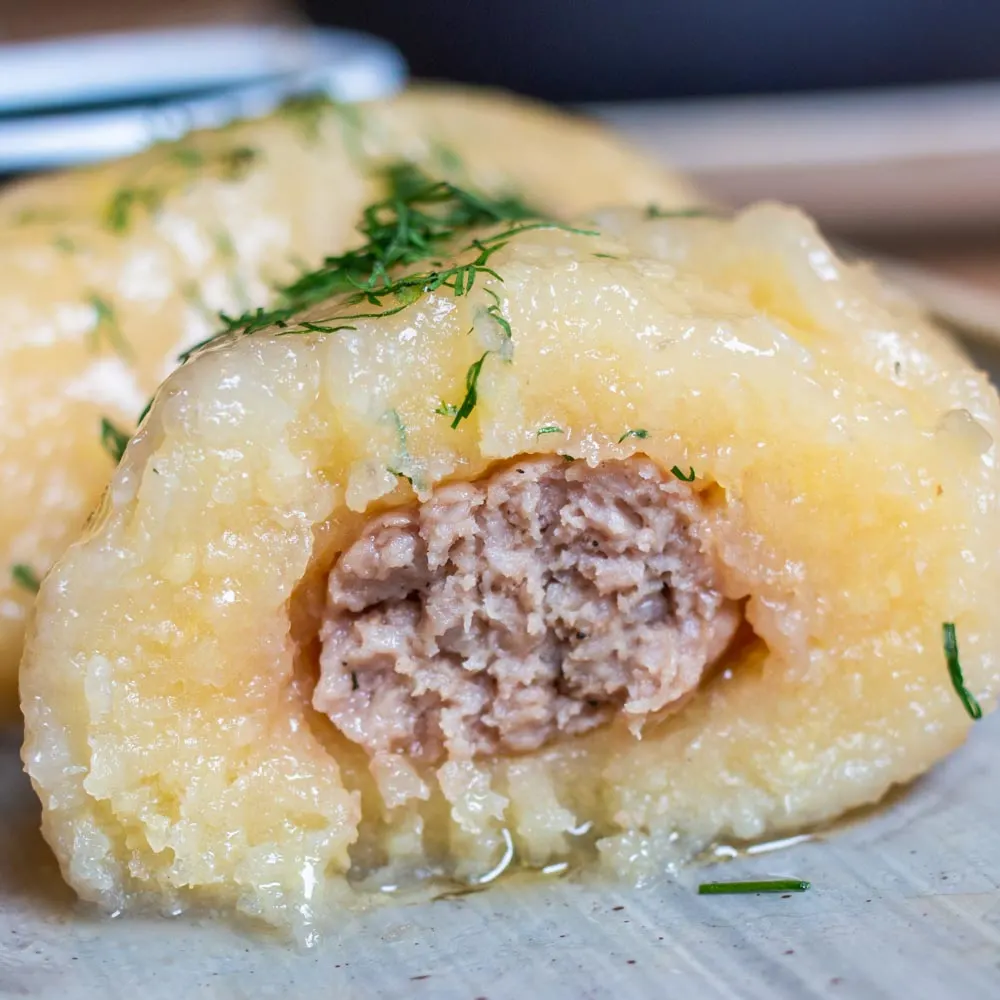
Also known as Didžkukuliai, Cepelinai is the first dish all visitors should try when they arrive in Lithuania. Not only is it considered to be the country’s national dish, but it’s also a great meal to enjoy with a mug or two of Lithuanian beer
Cepelinai got its name due to its similarity to the zeppelin airship, both in shape and size. But, when it comes down to it, a Cepelinas is basically a meat-filled potato dumpling similar to dumplings served in countries like Austria, Belarus, Germany and Poland. Think of it as a knödel that meets a pierogi.
Plan to eat these Lithuanian dumplings with sour cream ladled on top or served on the side. If you’re vegetarian, you can replace the meat filling with curd cheese or mushrooms.
2. Šaltibarščiai (Cold Beet Soup)
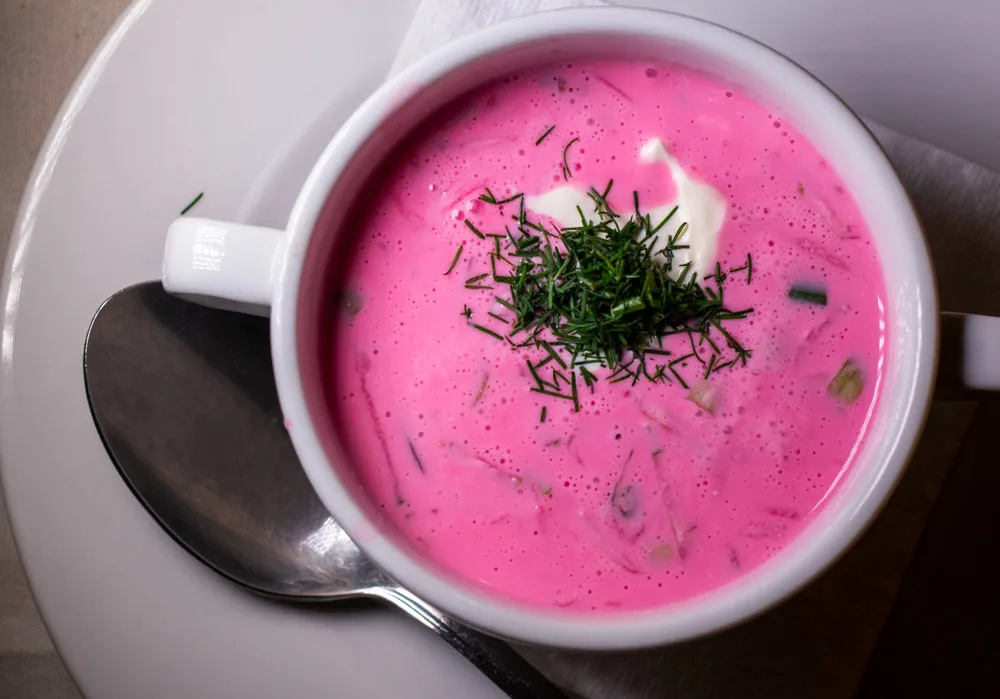
Leave your impressions at home when you taste Šaltibarščiai for the first time. Despite its vivid pink color, this iconic chilled Lithuanian soup is as refreshing as it is bright.
Similar to Borscht in Poland, Šaltibarščiai gets its pink color from beets. The soup’s other ingredients include cucumber, dill, green onions, hard boiled eggs and kefir (a fermented milk product made with kefir grains).
Lithuanians typically top Šaltibarščiai with sour cream and fresh dill and eat the chilled soup with potatoes on the side. The combination of a bowl of chilled soup and crispy potatoes is a winner.
Discover more of the best soups in the world.
3. Bulviniai Blynai (Potato Pancakes)
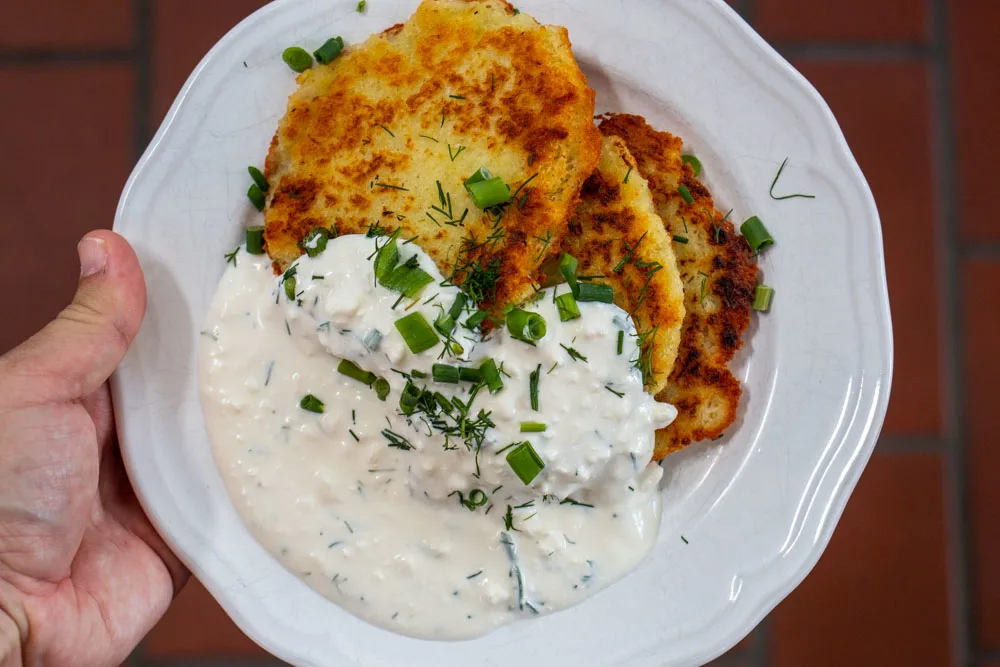
Lithuanians have been eating potatoes for a relatively short time – just a couple centuries – but dishes featuring the economical tuber are an integral part of their cuisine. They boil the starchy spuds and add them to soups, kugels and dumplings. They also fry them to create crispy Lithuanian potato pancakes called Bulviniai Blynai.
Similar to Potato Latkes that we ate during our youth and Kartoffelpuffer that we ate at Hamburg Christmas markets, Bulviniai Blynai are fried pancakes made with savory ingredients like grated potatoes, onions, eggs and flour. Most Lithuanians eat Bulviniai Blynai topped with sour cream or apple sauce.
4. Kepta Duona (Fried Bread with Garlic)
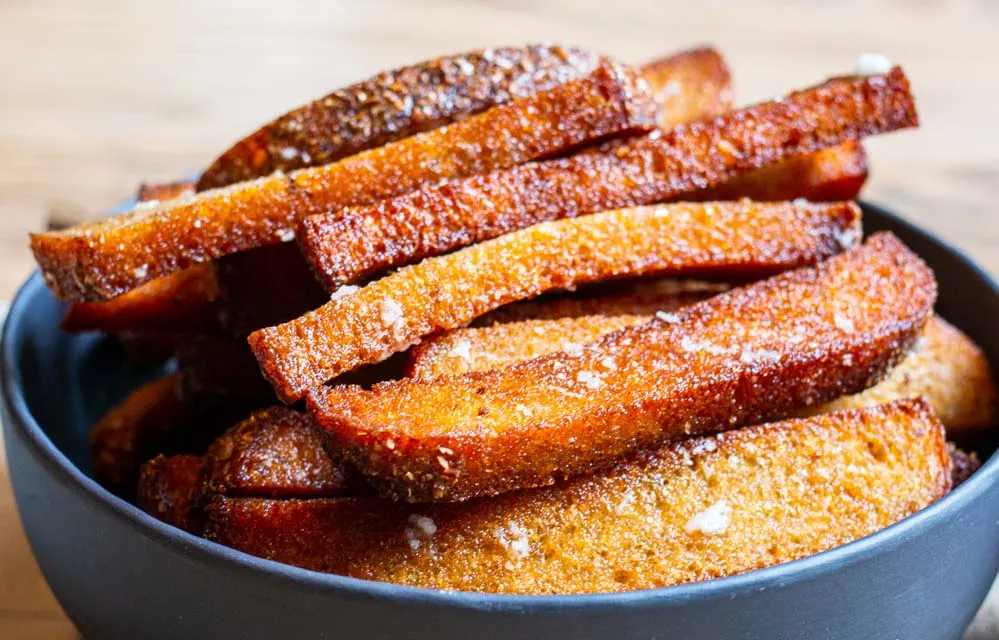
If Bulviniai Blynai is Lithuania’s best potato dish, then Kepta Duona is the country’s best bar snack. Not only is the dish cheap and easy to prepare, but it also pairs well with Lithuanian beer.
Although Kepta Duona translates to baked bread, Lithuanian cooks fry strips of dark rye in oil before rubbing them with garlic. The end result is addictively crunchy, especially when dipped into cheese sauce.
5. Kibinai (Meat-Filled Pastries)
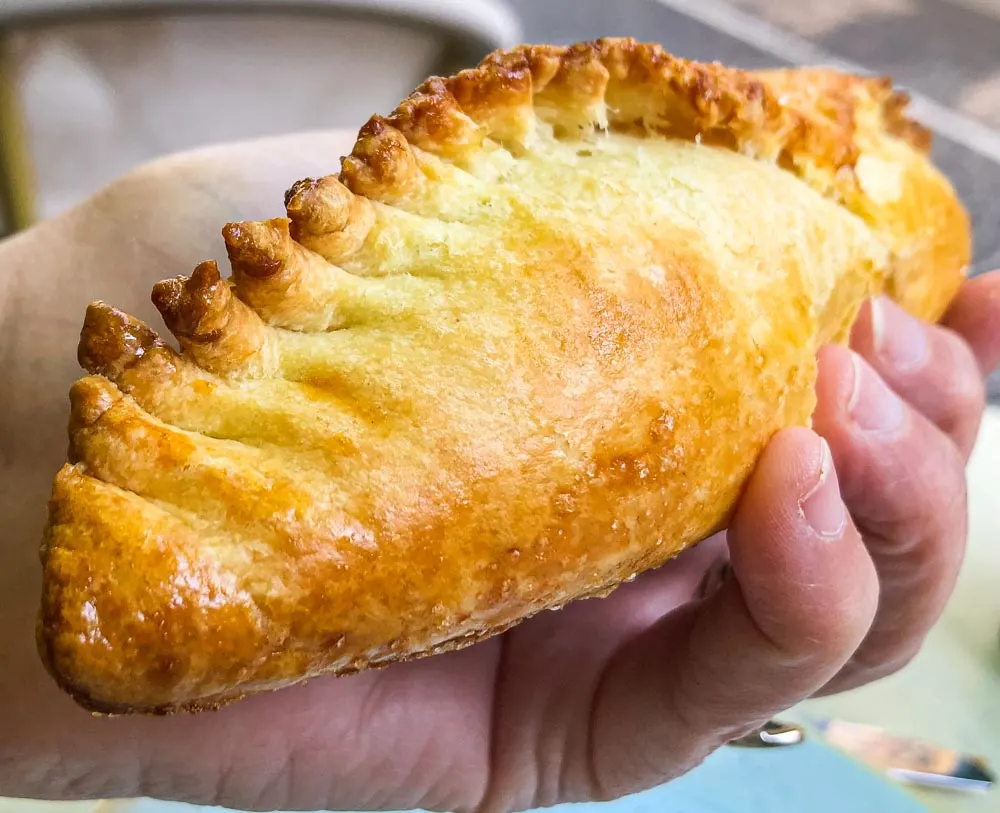
Reminiscent of meat pies in London and Burek in Zagreb, Kibinai are crescent-shaped pies traditionally stuffed with a savory lamb filling. Other filling options include chicken, curd cheese and fruit.
Originally introduced by the Jewish Karaite sect who immigrated to Lithuania from Crimea during the Middle Ages, Kibinai have withstood the test of time and changing tastes. Though they’re most popular in Trakai, resourceful food travelers can find these filled pastries throughout Lithuania.
6. Žirniai Su Spirgučiais (Peas with Cracklings)
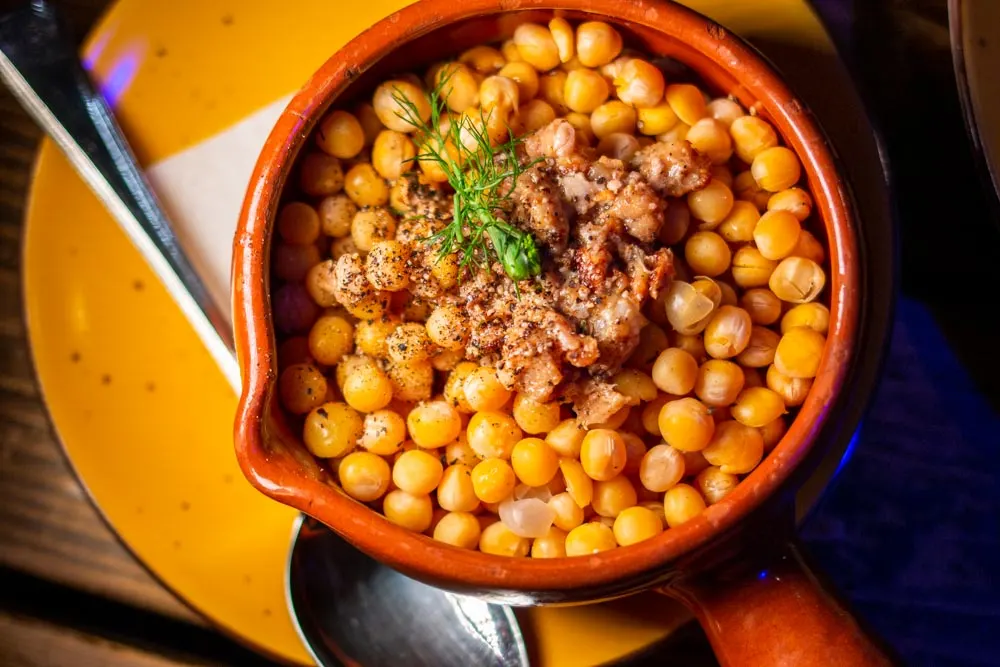
Žirniai su Spirgučiais is a bar snack that’s not only popular in Lithuania but also in neighboring Baltic states like Latvia. Though the dish translates to peas with cracklings, it reminded us of eating corn nuts.
To make Žirniai su Spirgučiais, cooks boil small yellow peas before pan frying them with smoked bacon. The result is a salty, protein-rich snack that pairs well with beer.
Local Lithuanian Products
Lithuanian cuisine features wholesome ingredients that locals grow on farms, find in forests and pluck from the water. These ingredients took on heightened importance when market options were sparse during the communist era.
Although communism is now a memory, many Lithuanians choose to eat local products both at home and in restaurants. Not only are these foods traditional, but they’re also healthy and ecologically sustainable.
7. Juoda Duona (Dark Rye Bread)
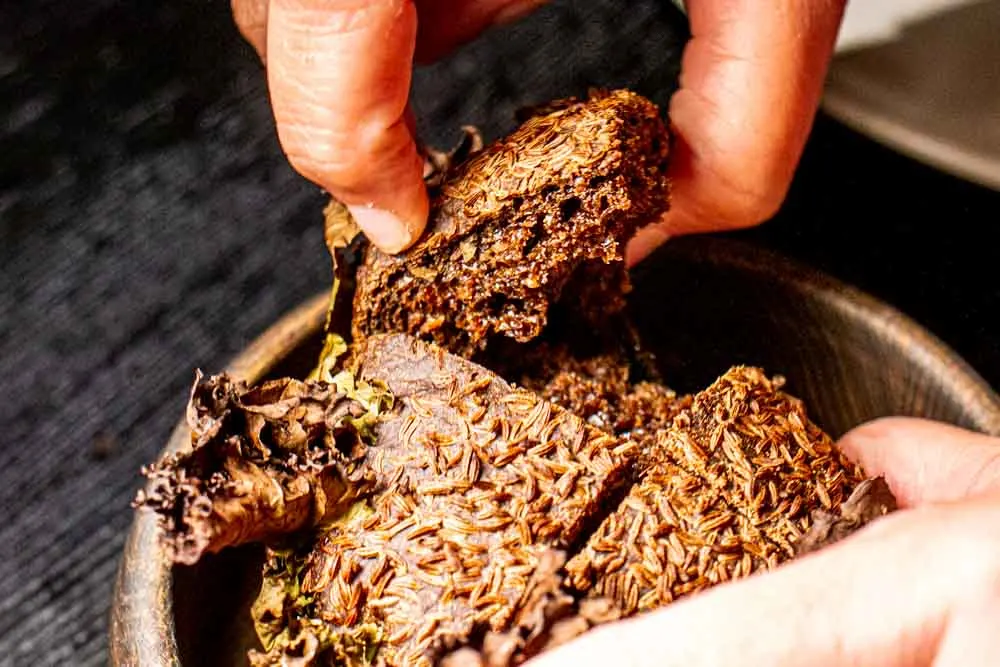
Though Lithuanian farmers mill grains like wheat, rye and buckwheat, the country’s most traditional Lithuanian bread is made with natural yeast and dark rye flour. Though traditionally baked at home, dark rye bread is available at markets and restaurants too.
Beyond pairing the bread with soup, Lithuanian restaurants use the bread as a base for hearty sandwiches and fry it in strips to make Kepta Duona. In other words, you won’t have any difficulty finding dark rye bread in Lithuania.
8. Marinuoti Agurkai (Pickles)
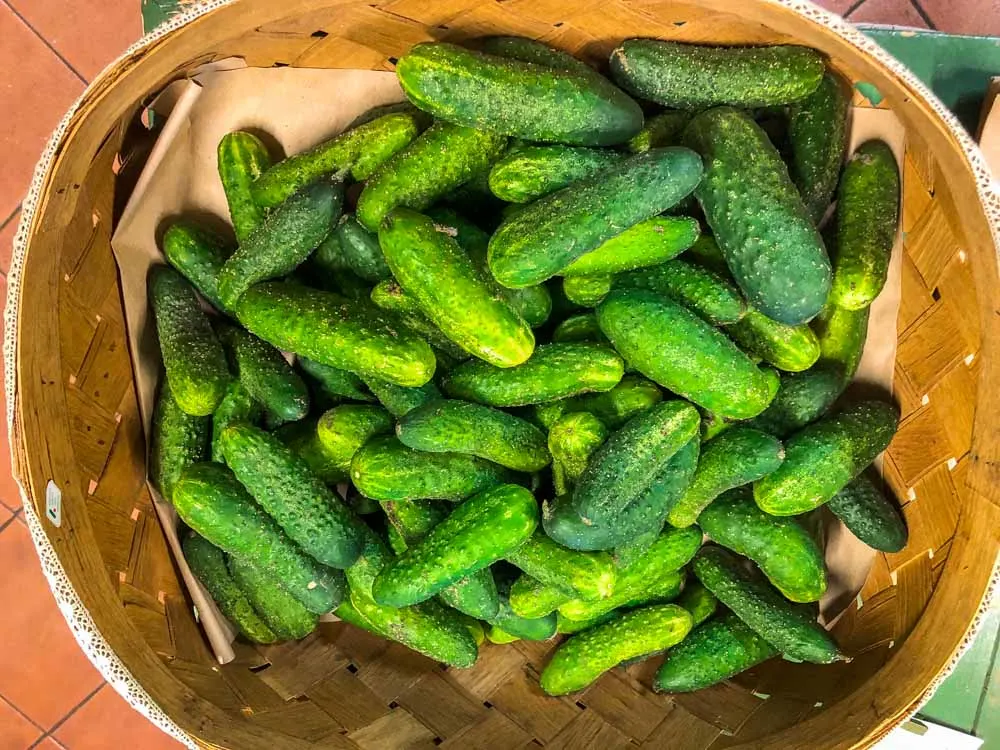
Especially popular with the country’s former Jewish population, pickles were a staple that Lithuanians traditionally made at home by fermenting cucumbers and beets in wooden barrels. Industrious home cooks would start the pickling process each spring and enjoy the fruits (or should we say vegetables?) of their labor all year long.
Though some Lithuanians still pickle vegetables at home, the easier option is to buy pickles at markets like Vilnius’ Halės Turgus. If you join the pickle party, you can eat your bounty as a snack or pair them with potatoes or a bowl of cold beetroot soup.
9. Sūris (Cheese)
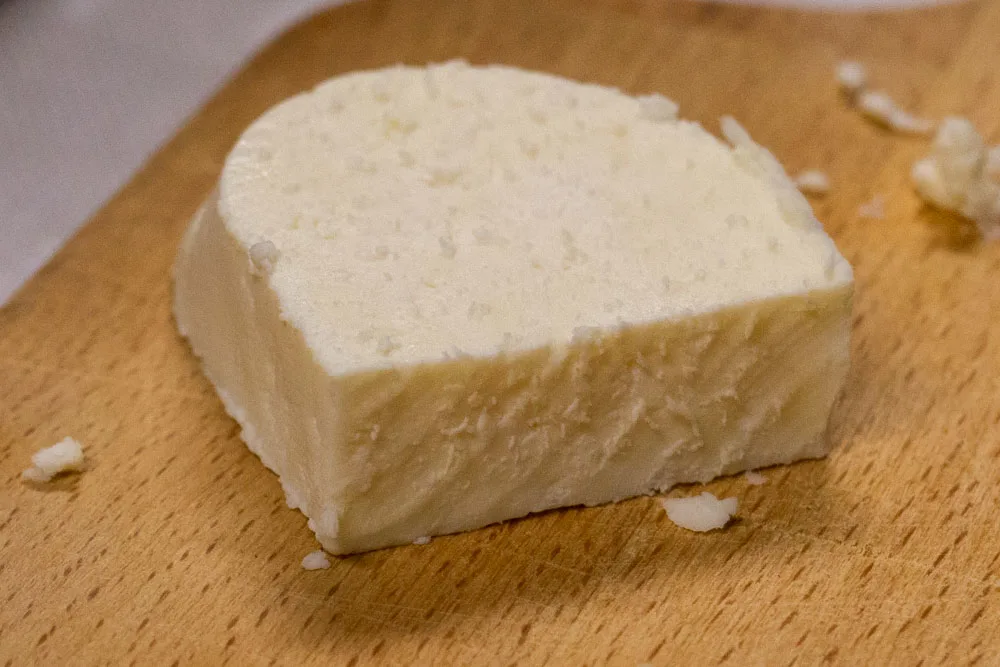
Though not as famous as cheese produced in countries like France and Italy, the production of Lithuanian cheese dates back centuries. Curd cheese is the most typical variety, but a few Lithuanian cheeses have achieved Protected Geographical Indication (PGI) status.
You’ll likely find soft curd cheese on breakfast menus as well as at local markets and food shops. Eat it with rye bread and honey. This combination is a Lithuanian classic.
10. Skilandis (Cold Smoked Cured Sausage)
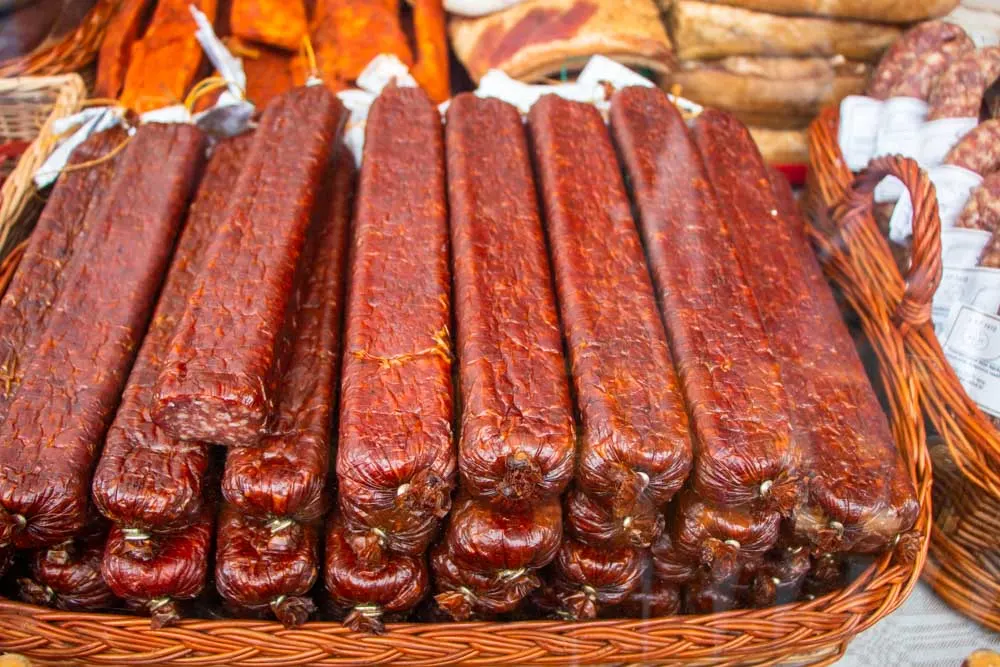
Despite the abundance of vegetables and grains in Lithuania, meat plays an equally important role in the country’s cuisine. A prime example is Skilandis, a cold smoked cured sausage that’s popular with locals.
From a technical perspective, artisans prepare Skilandis by stuffing a pig stomach casing with seasoned minced pork, dry smoking it and letting it mature. The end result is a quality charcuterie that carnivores buy at markets and serve when entertaining.
11. Lašiniai (Lardo)
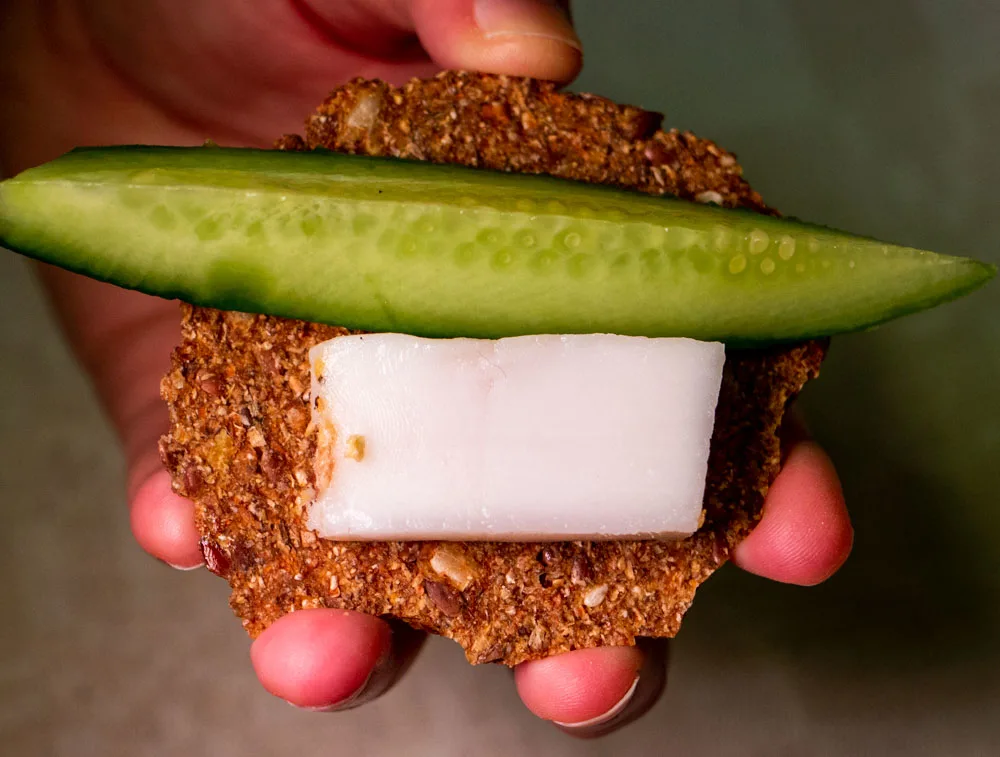
Similar to Salo in Russia and Lardo in Italy, Lašiniai is a traditional Lithuanian smoked meat product made with pork fatback and seasoned with salt, pepper and garlic.
After buying this porky product at markets and butchers, locals eat thick slabs atop sliced dark rye bread. For a fun twist, you can pair Lašiniai with pickles to create a unique snack.
12. Žuvis (Fish)
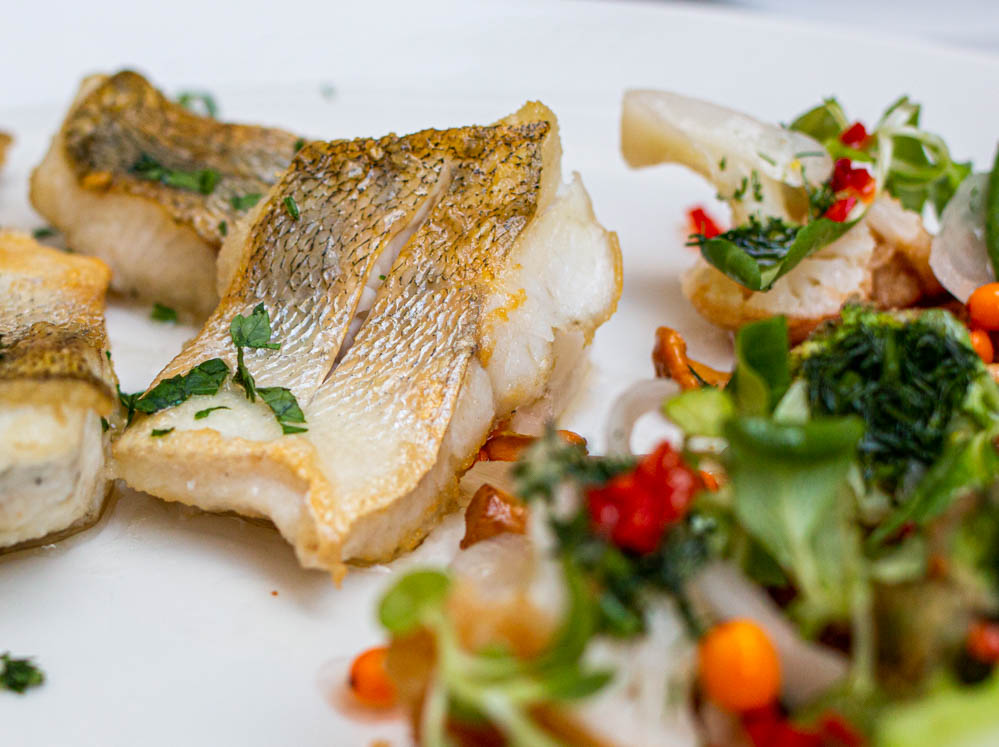
Lithuanians eat a variety of fish including pike, perch, cod and bream. However, herring takes the number one position when it comes to popularity of aquatic protein swimming in the country’s waterways.
Regardless of the season, you’ll likely find fish on a Lithuanian menu. Restaurants bake, smoke and salt fish and serve them with carb-friendly sides like boiled potatoes, mashed potatoes and dark rye bread.
Regional Favorites
With so many people passing through Lithuania over the ages, it was inevitable that many would leave their mark.
Food travelers who dig their utensils deep will uncover contributions from countries like Italy, France and Germany; however, it doesn’t take special effort to find Jewish and Russian influences in Lithuanian food.
If you’re intrigued to explore these global influences, start with the following Lithuanian dishes:
13. Beigels (Bagels)
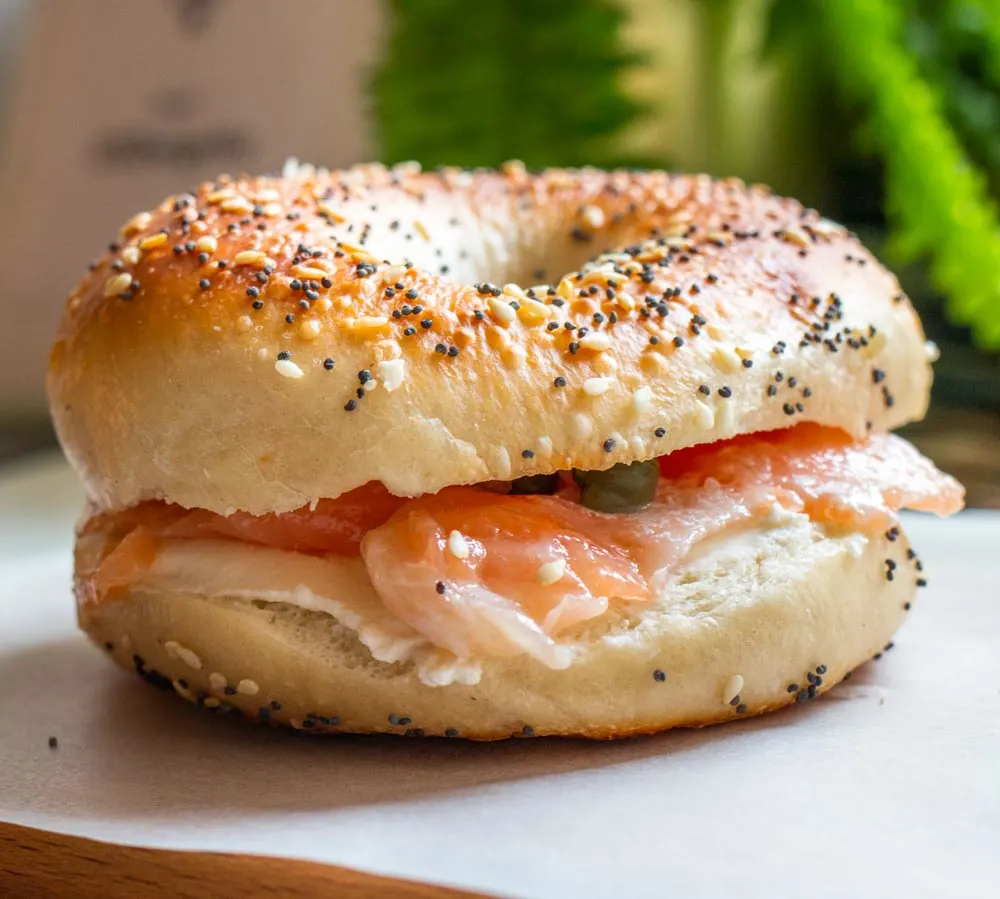
Introduced by Polish immigrants and dating back to the 17th century, bagels were popular with Lithuania’s Jewish diaspora until World War II. Sadly, the bagel’s popularity died in Lithuania when over 90% of the country’s Jewish population was killed during the Holocaust. After several decades of exile, ex-pats have brought bagels back to Lithuania
Visitors to modern Lithuania won’t encounter many Jews but at least they can find the dense, ring-shaped bread product at relatively new beigel shops as well as at donut shops and food markets. Though typical toppings include cream cheese and smoked salmon, almost anything goes when it comes to eating bagels in Lithuania.
14. Chiburekki (Fried Meat-Filled Turnover)
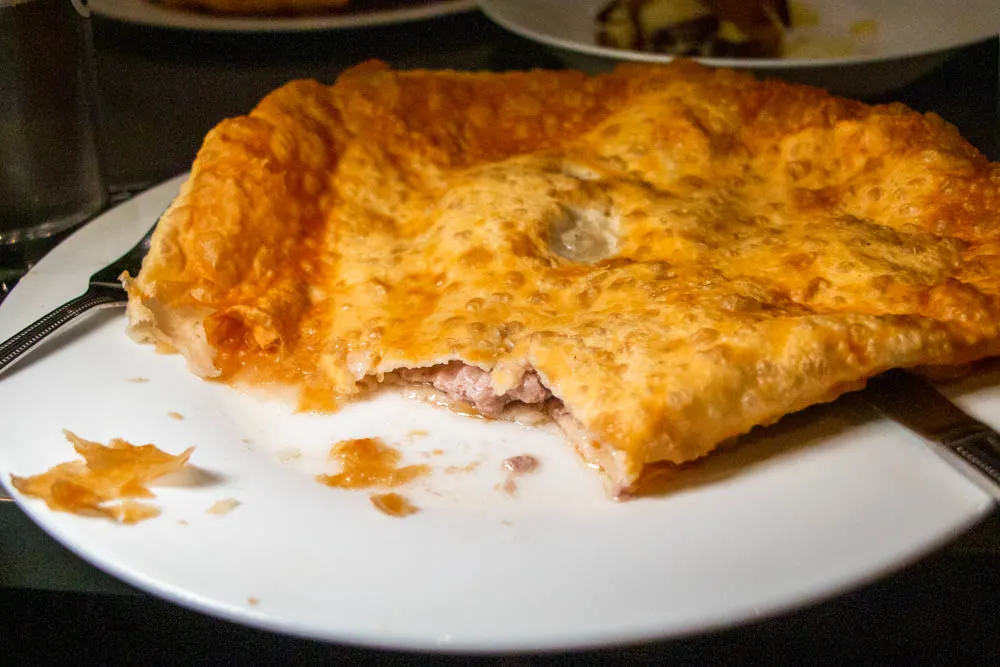
Although Lithuania declared its sovereignty from the Soviet Union in 1990 and joined the European Union in 2004, remnants of Russian cuisine remain decades later. And this phenomena doesn’t contemplate dishes like herring and borscht that are historically popular in both countries.
The Chiburekki is a great Russian dish for curious food travelers to eat in modern Lithuania. Although the deep-fried turnover is similar to Kibinai both in shape (crescent) and origin (Crimea), it’s a more difficult food to find. In other words, if you see a Chiburekki on a Lithuanian menu, order and eat it.
Lithuanian Desserts
Desserts in Lithuania run the gamut from cookies shaped like mushrooms (Sausainiai Grybukai) to fried dough shaped like angel wings (Žagarėliai). Some Lithuanian desserts incorporate local products like honey, curd cheese and poppy seeds while others feature chocolate sourced from faraway destinations.
We recommend the following sweet treats if you only have stomach space to sample two Lithuanian desserts,
15. Šakotis (Cake)
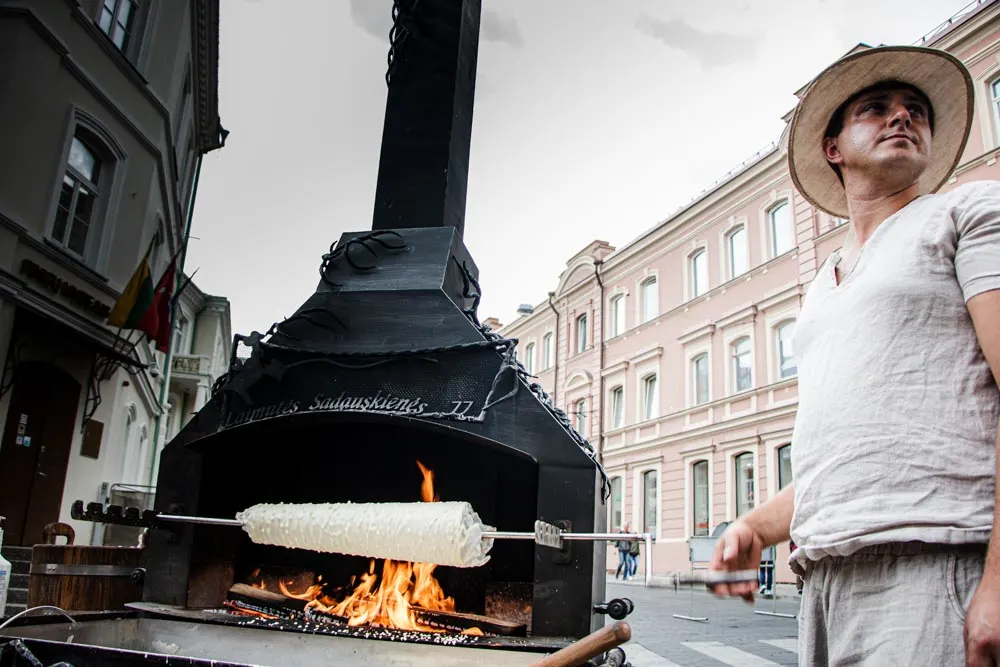
Shaped like a tree with jagged branches, Sakotis is a festive Lithuanian cake served at weddings and eaten on holidays like Easter and Christmas Eve. Despite having simple ingredients like butter, cream, eggs and flour, a Sakotis cake develops a spiky appearance while it bakes on a horizontal spit.
Dating back to the 17th century, this traditional dessert originated in Poland as Sękacz. Variations of the original remain popular in that country as well as in Germany (Kurtoskalacs), Hungary (Baumkuchen) and, of course, Lithuania.
16. Varškės Spurgos (Curd Cheese Donuts)
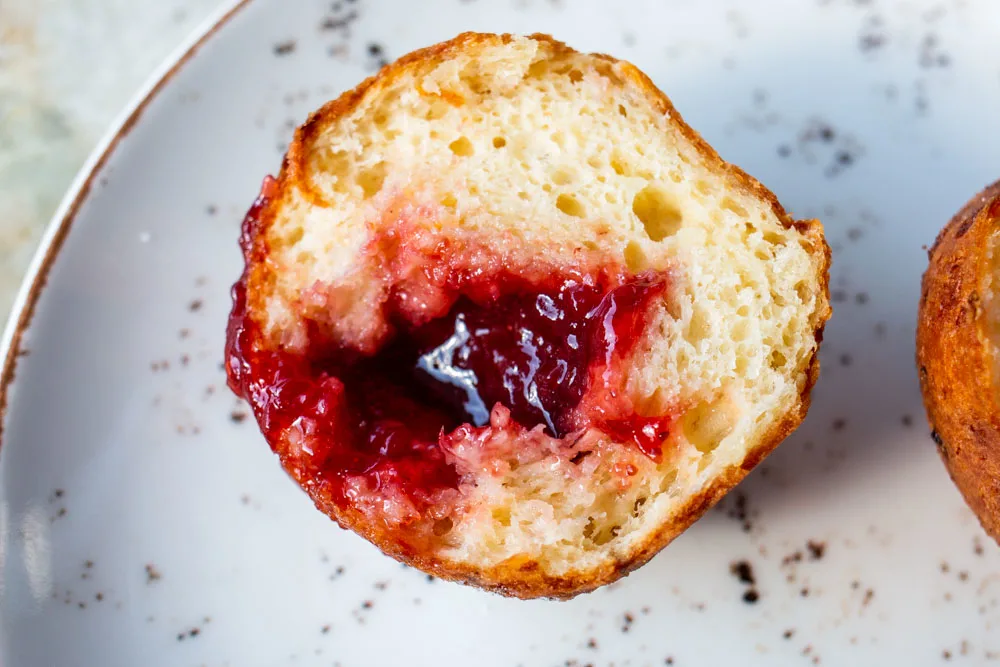
Although donuts are popular around the world, Lithuanian donuts called Varškės Spurgos are unique due to an extra ingredient – curd cheese. Shaped into balls, these fun desserts typically come dusted with powdered sugar and occasionally filled with fruit jam.
Varškės Spurgos are relatively easy to bake and just require a handful of ingredients beyond curd cheese. If you’re lucky, you may be invited to a Lithuanian home where you can try fluffy curd cheese donuts straight out of the oven. Otherwise, you can find them at Lithuanian bakeries and donut shops.
Discover more great donuts eaten around the world.
Lithuanian Drinks
If you think Lithuanians drink a lot, you are correct. Lithuanians lead the European Union with a per capita average of 15 liters of alcohol per person each year. The Czech Republic, Germany, Ireland and Luxembourg complete the top five in this dubious contest.
This status is not necessarily new. Lithuanians have been drinking a range of beverages for a millennium and have exported vodka for centuries. We ‘researched’ this history at bars, pubs and coffee bars.
Read our Vilnius Nightlife Guide.
Based on our dip into the country’s liquid libations, we recommend the following traditional Lithuanian beverages:
17. Alus (Beer)
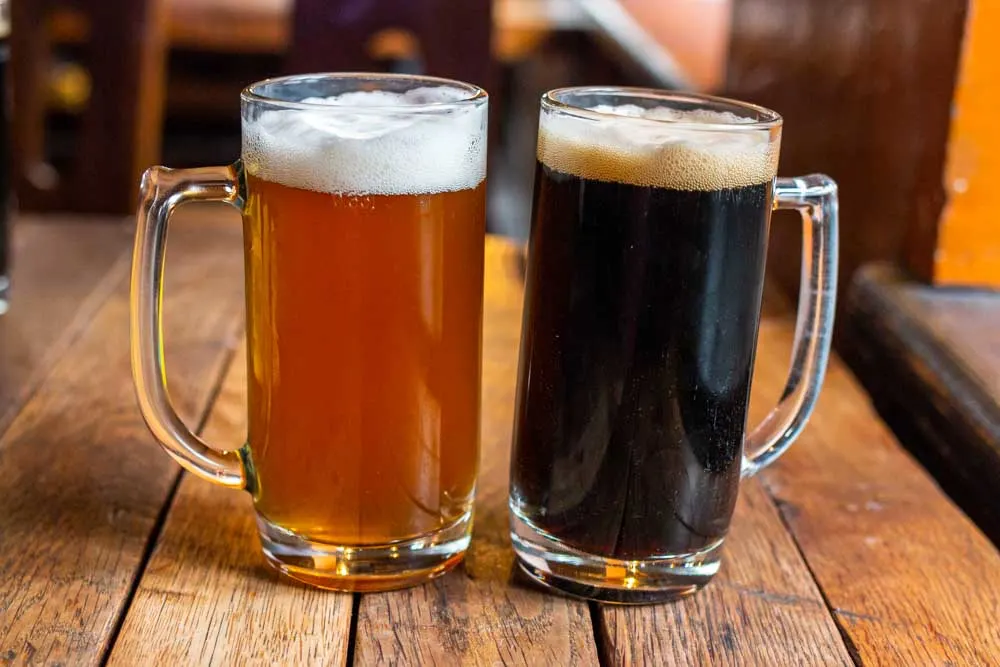
Lithuanian vodka may be known around the world, but it’s not the most popular alcoholic drink in the Baltic country. That honor goes to beer.
Known as Alus in Lithuania, beer has played a role in Lithuanian society since locals started brewing farmhouse ales as far back as the 11th century. Beer enthusiasts can still imbibe those same ales as well as craft beer produced at microbreweries.
Diehards can chug down unboiled beer at spots like Šnekutis in Vilnius. Other options are to take a Vilnius beer tour or follow one of Lithuania’s beer trails.
18. Midus (Mead)
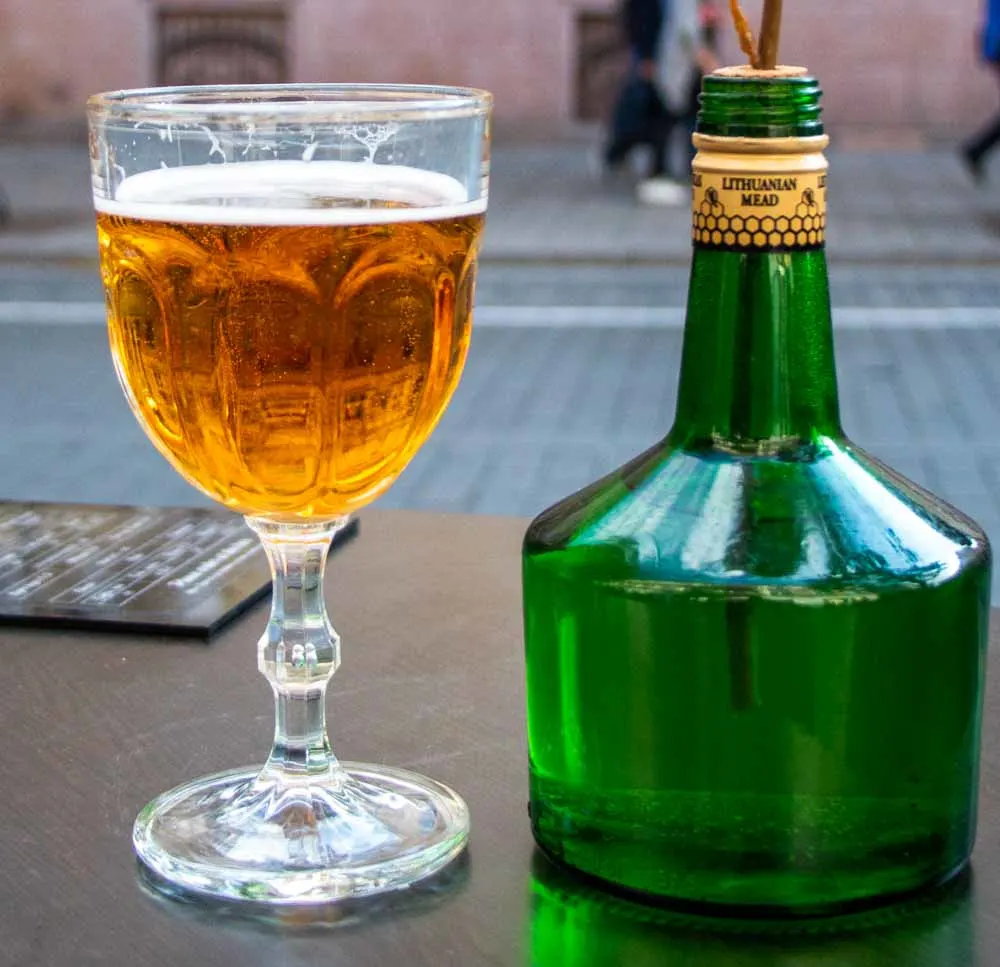
Drinking Midus (mead) is a must in Lithuania. Not only has the country’s fermented honey wine achieved Protected Geographical Indication (PGI) status, but its sweet flavor is enhanced by the addition of ingredients like berries, lemon, cinnamon, thyme and even hops.
Mead’s history pre-dates beer in Lithuania, making it the country’s alcohol elder statesman. Despite its advanced age, mead is experiencing a popularity resurgence with pubs offering this ancient ‘drink of the gods’ as an alternative to craft beer and cider.
19. Vaisinis Vynas (Fruit Wine)
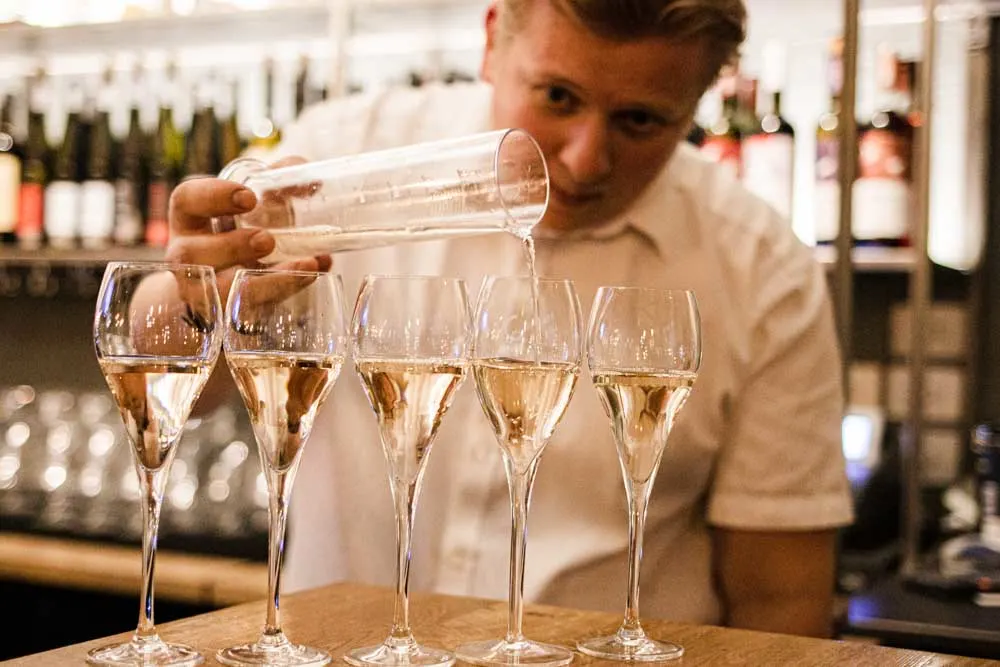
Lithuanian wines are different from varietals produced in countries like Spain and South Africa. Due to the country’s cooler Nordic climate, Lithuanian winemakers use fruits like apples, blueberries and black currants instead of grapes.
Traveling oenophiles may thumb their noses but they’d miss out on trying a style of wine that’s completely ‘of place’ and produced in the spirit of Lithuania’s sustainable food culture. Plus, not all Lithuanian fruit wines are cloyingly sweet. Some are surprisingly dry and well worth drinking.
20. Kava (Coffee)
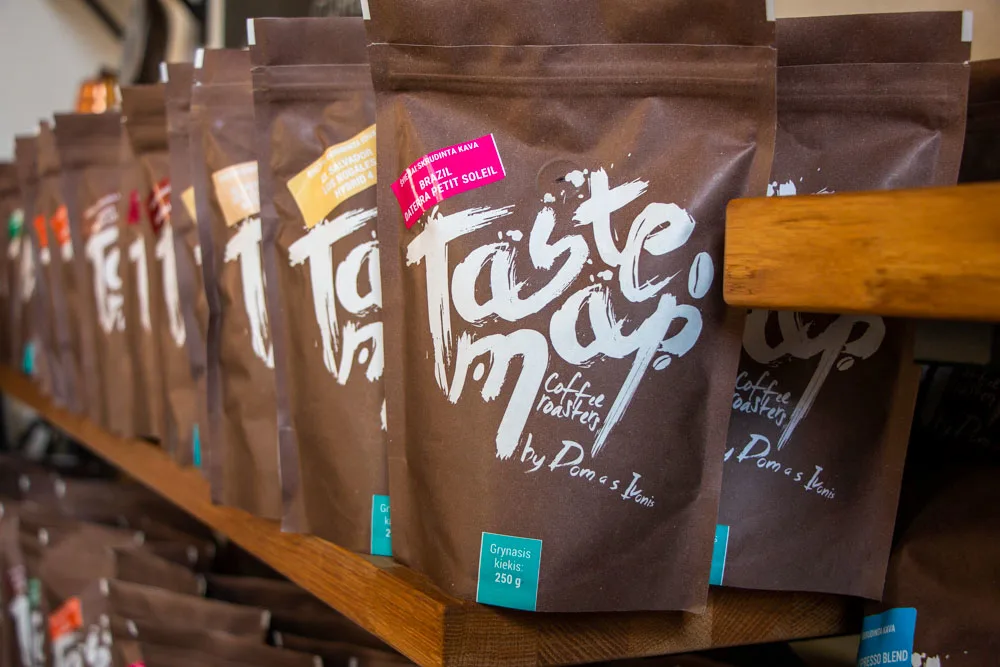
Dating back centuries, coffee was originally a specialty item exclusively enjoyed by Lithuanian nobility. Though it later achieved wide scale popularity across the country, coffee resumed its status of a luxury drink during the Soviet years when beans were scarce in Lithuanian markets.
Lithuanian coffee’s long, bumpy coffee history is now in the past. A new generation of Vilnius baristas and roasters has embraced the third wave coffee movement, making flat whites and filtered coffee readily available at specialty coffee shops in the capital city.
Read our Vilnius Coffee Guide.
Frequently Asked Questions
Lithuania is famous for pink soup called Šaltibarščiai. Not only is this cold beet soup pink, it’s also delicious.
Traditional Lithuanian food has influences from countries like Italy, France, Germany, Turkey and Russia. Typical dishes include Cepelinai (potato dumplings filled with minced meat), Bulviniai Blynai (potato pancakes) and Kepta Duona (fried bread with garlic).
No. Tipping is optional in Lithuania.
Although mead, kvass and gira are iconic Lithuanian drinks, beer is especially popular in the Baltic country.
Video Recap

About the Authors
Daryl and Mindi Hirsch
Saveur Magazine’s BEST TRAVEL BLOG award winners Daryl and Mindi Hirsch share their culinary travel experiences and recipes on the 2foodtrippers website. Since launching the site in 2012, they’ve traveled to over 40 countries in their quest to bring readers a unique taste of the world.
Original Publication Date: September 4, 2020

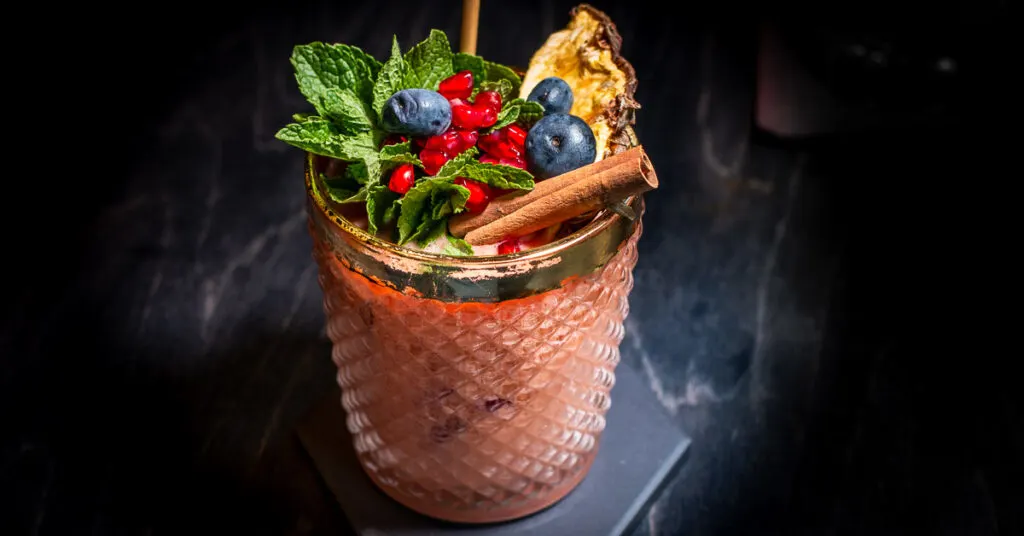
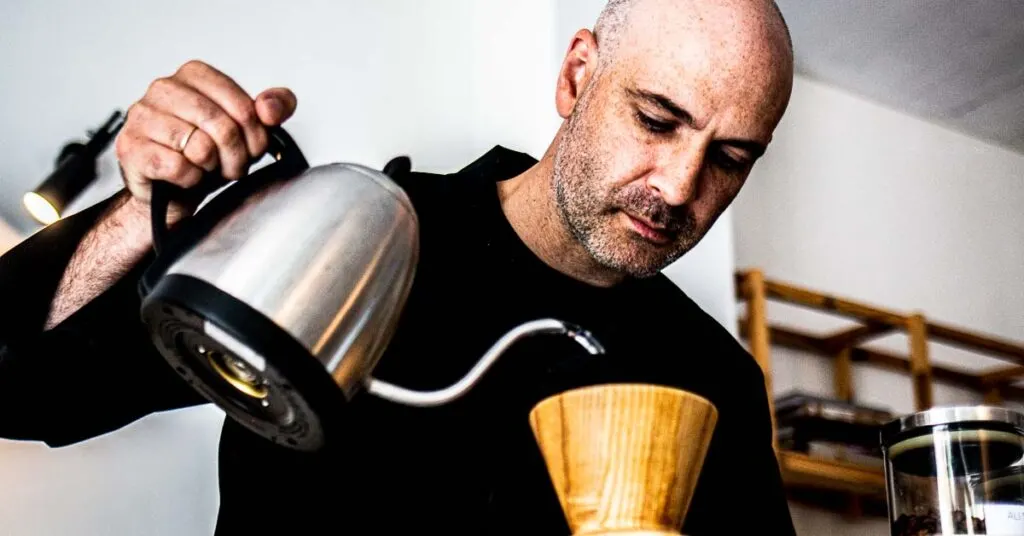
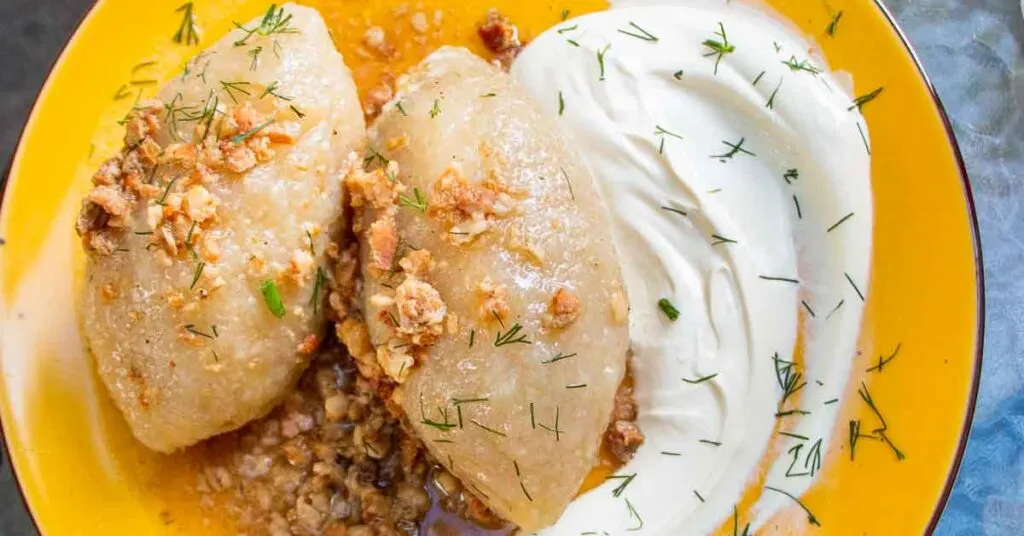
Vilma
Saturday 23rd of September 2023
Great article. One correction though - cepelinai and didžiuliai are two different dishes. Cepelinai are made with fresh grated potatoes mainly meat filling, and didžkukuliai are made with boiled potatoes and filling mainy is with cheese curd with crackles. Even Lithuanians use both as synonyms. Also, I was surprised that two dishes were not mentioned here. Kugelis (potatoe pie) and dessert Tinginys (lazy cake). These are very traditional and popular.
Jan
Friday 15th of September 2023
So glad to have found this page! I’m of Lithuanian descent on both sides (Mother said we were descended from the Vilna Gaon) and it was fun to see the different foods. Explains my love of beets, bagels and burrekas (in Israel)!
GFortinsky
Monday 2nd of January 2023
You won't find Jews but at least you'll find bagels? Is that for real?? Who wrote that?! My mother is a Holocaust survivor and her whole family was killed in the Holocaust -- little known fact, most of the killing was done by native Lithuanians with very little encouragement from the Nazis, much of the slaughter took place before the Nazis even entered Lithuania. And at least the bagels came back? What tone deaf insensitive creature would write something like that?
Vilma
Saturday 23rd of September 2023
@GFortinsky, I'm sorry your family experienced the history at it's worst. But the authors did not say that. On the other hand, I felt a bit uneasy when you stated "little known fact, most of the killing was done by native Lithuanians with very little encouragement from the Nazis" - when this horrific Nazi invasion started, Lithuania was taken over and supressed by Nazis. Lithuania was one of the countries that tried supporting Jews. My grandparents experienced that first hand and parents grew up in the aftermath. Myself growing up in '70-'80 I have a wide experience of my own, and stories from close relatives who experienced '40 and '60. So claiming this "little known fact abut native Lithuanians", it's just not right.
Daryl and Mindi Hirsch
Tuesday 3rd of January 2023
We never said that and were quite sensitive on the issue. Thanks for reading.
Joan Dondero
Sunday 7th of November 2021
Daryl & Mindi....Thank you so very much 🙏🏼 on your fantastic travel & report about LITHUANIA... !!! I am 100% Lithuanian descent/2nd generation American. This was more interesting information then I ever knew about my ancestors land. I knew about Russia’s domination, but God blessed American, indeed, since I met Russian descent best friends at my job where I worked in a business when I was young. Some of the meals I remember from my paternal “granny”. Maternal grandmother died when I was 6 years old. She was older. We called her “mociute”. God bless you! Joan D.